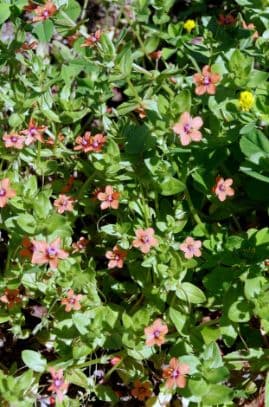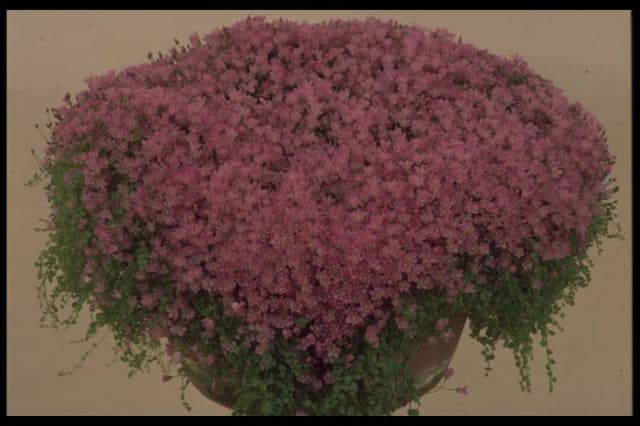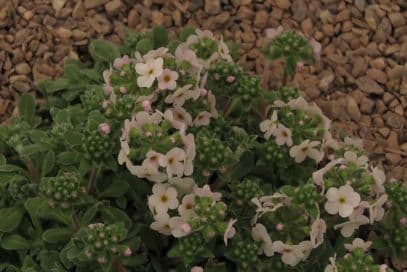Eastern cyclamen Cyclamen coum subsp. coum f. coum (Pewter Group) 'Maurice Dryden'

ABOUT
The plant known as Cyclamen has striking features that make it a captivating addition to gardens and indoor spaces alike. It boasts heart-shaped leaves that exhibit a beautiful silver marbling on the surface, a characteristic that is particularly notable within the 'Maurice Dryden' variety from the Pewter Group. This marbling provides a metallic sheen, standing out against the remainder of the green foliage. These plants are also admired for their delicate flowers, which emerge with a touch of elegance. The blooms may present themselves in various shades of pink, ranging from soft pastels to deeper hues, occasionally even approaching a rich magenta color. These flowers typically display a reflexed shape, meaning their petals sweep upwards and outwards, forming a graceful silhouette. Adding to the charm of Cyclamen 'Maurice Dryden', the flowers have a symmetrical form and a dainty, yet striking, presence that can catch the eye and provide a pop of color during their blooming season. Furthermore, the base of the petals often features a distinctive darker coloration which highlights the mouth of the flower and contrasts against the main shade of the petals. Overall, this plant is notable for its combination of the lustrous, patterned foliage and the pretty, vibrant flowers that create a lovely contrast and add visual interest wherever they are planted.
About this plant
 Names
NamesSynonyms
Eastern Cyclamen, Persian Violet.
Common names
Cyclamen coum subsp. coum f. coum (Pewter Group) 'Maurice Dryden'
 Toxicity
ToxicityTo humans
Cyclamen, in general, contains toxic compounds, particularly in the tubers and roots, which can be harmful if ingested by humans. Symptoms of cyclamen poisoning may include gastrointestinal discomfort such as vomiting, diarrhea, and abdominal pain. In large quantities, cyclamen toxicity can potentially lead to more severe symptoms including heart rhythm abnormalities and seizures.
To pets
Cyclamen is also toxic to pets like dogs and cats, with the tubers being the most poisonous part. If a pet ingests cyclamen, symptoms might include vomiting, diarrhea, drooling, and a decrease in appetite. Severe poisoning can cause heart rhythm abnormalities, seizures, and even death, so it is important to keep cyclamen out of reach of pets and seek veterinary care immediately if ingestion is suspected.
 Characteristics
CharacteristicsLife cycle
Perennials
Foliage type
Evergreen
Color of leaves
Variegated
Flower color
Pink
Height
6 inches (15 cm)
Spread
6 inches (15 cm)
Plant type
Bulb
Hardiness zones
5
Native area
Mediterranean
Benefits
 General Benefits
General Benefits- Ornamental Value: Cyclamen coum 'Maurice Dryden' has attractive foliage and flowers, making it a popular choice for ornamental use in gardens and as a houseplant.
- Seasonal Interest: With its winter and early spring blooms, this plant provides color and interest during a time when few other plants are flowering.
- Shade Tolerance: It can thrive in partial to full shade, making it suitable for woodland gardens and shaded borders.
- Drought Resistance: Once established, it is relatively drought-tolerant, requiring minimal watering.
- Low Maintenance: It is generally easy to care for and does not require frequent maintenance, making it a good choice for gardeners of all levels.
- Compact Growth: The plant has a compact growth habit, which makes it suitable for small gardens or as an underplanting for larger shrubs.
- Pollinator Attraction: The flowers can attract pollinating insects such as bees, which are important for the ecosystem.
 Medical Properties
Medical PropertiesThis plant is not used for medical purposes.
 Air-purifying Qualities
Air-purifying QualitiesThis plant is not specifically known for air purifying qualities.
 Other Uses
Other Uses- Cyclamen coum leaves can be used to create botanical prints on fabric or paper, a process where the plant's natural pigments are transferred to create unique patterns and designs.
- The tuber of the Cyclamen, being semi-poisonous, was historically used as a fishing tool by crushing it in water to stupefy fish, making them easier to catch.
- Dried Cyclamen flowers can be incorporated into potpourri mixtures, adding fragrance and a touch of color to the blend.
- The patterns of the leaves can inspire artists and designers in creating natural, organic motifs for textiles, wallpapers, and other decorative items.
- Cyclamen plants can be used in educational settings, such as schools and botanical gardens, to teach students and visitors about plant biology and the growth cycles of perennial plants.
- As a symbol of love and tenderness in the language of flowers, Cyclamen can be used in crafting and gifting, particularly in handmade Valentine’s Day or anniversary cards.
- Broken pieces of Cyclamen tuber can serve as a natural, though not commercially recommended, deterrent for moles and voles when spread around in a garden.
- Cyclamen coum's vibrant and varied hues can be used as a model for artists to practice color mixing and to understand the nuances of shade and tone in painting.
- The plant can be part of sensory gardens, especially designed for the visually impaired, as it features textured leaves and a distinctive fragrance.
- During festive seasons, Cyclamen flowers and leaves can be incorporated into decorative wreaths or centerpieces for their attractive appearance.
Interesting Facts
 Feng Shui
Feng ShuiThe Cyclamen is not used in Feng Shui practice.
 Zodiac Sign Compitability
Zodiac Sign CompitabilityThe Cyclamen is not used in astrology practice.
 Plant Symbolism
Plant Symbolism- Deep Love: The cyclamen, often associated with deep love, symbolizes the enduring and passionate feelings one person can hold for another, capturing an almost motherly love when given as a gift.
- Goodbye: In the language of flowers, giving a cyclamen can signify a parting or a respectful, sorrowful goodbye, perhaps due to its lifecycle that includes a period of dormancy.
- Sincerity: Cyclamens are thought to represent sincerity due to their upright growth and heartfelt shaped leaves, often used to convey honest emotions.
- Shyness: The cyclamen's nodding flowers that seem to shyly turn downward have led them to be associated with diffidence and bashfulness in the symbolic language of plants.
 Water
WaterEastern cyclamen requires careful watering during active growth, which typically occurs in fall, winter, and spring. Water the plant thoroughly when the soil surface feels dry to the touch, approximately once a week. Avoid waterlogging as this can lead to tuber rot. Depending on the room temperature and plant size, one might need about 8-16 ounces of water every 7 days. During the summer dormancy period, reduce watering significantly, allowing the soil to dry out completely.
 Light
LightEastern cyclamen thrives best in bright, indirect light conditions. The ideal spot would be near an east or north-facing window where it receives some morning sunlight but is sheltered from the harsh midday sun. Avoid direct sunlight, especially in the hot summer months, to prevent leaf scorching.
 Temperature
TemperatureEastern cyclamen prefers cooler temperatures ranging from 50 to 68 degrees Fahrenheit during active growth. The plant can survive minimum temperatures as low as 40 degrees Fahrenheit but should be protected from frost. Maintaining the temperature below 68 degrees Fahrenheit is crucial for flower bud formation and longevity.
 Pruning
PruningPruning eastern cyclamen involves the removal of yellowing or dead leaves and spent flowers to maintain plant health and appearance. This should be done as needed throughout the growing season. The best time for pruning is when you first notice parts of the plant dying back, typically after flowering has finished.
 Cleaning
CleaningAs needed
 Soil
SoilEastern Cyclamen thrives in well-draining soil that is rich in organic matter with a soil pH ranging from 6.5 to 7.5. A soil mix of equal parts perlite, peat, and potting compost is ideal for this plant.
 Repotting
RepottingEastern Cyclamen should be repotted every one to two years, usually after it finishes blooming and when the plant is dormant.
 Humidity & Misting
Humidity & MistingEastern Cyclamen prefers moderate to high humidity levels but will tolerate average household humidity.
 Suitable locations
Suitable locationsIndoor
Keep Eastern Cyclamen in bright, indirect light with cool temperatures.
Outdoor
Plant Eastern Cyclamen in light shade, shelter from harsh elements.
Hardiness zone
5-9 USDA
 Life cycle
Life cycleCyclamen coum 'Maurice Dryden' begins its life cycle when a seed germinates, typically in the spring, entering the seedling stage characterized by the emergence of a small tuber and cotyledons. As it matures, foliage develops in the form of heart-shaped, sometimes silver-patterned leaves during the fall, which is the vegetative growth stage. The plant enters the flowering stage usually in the late winter to early spring, producing small, upswept pink or white flowers with a distinctive magenta blotch at the base of each petal. Following pollination, the cyclamen sets seed, with the stem coiling to bring the seed pods to ground level, where they ripen and eventually release seeds to complete the reproductive cycle. During the summer, the plant goes dormant, with the foliage dying back, and the tuber rests underground until temperatures cool and the cycle begins anew with the next season's growth. This perennial plant can continue this cycle for several years, often self-seeding in conducive conditions.
 Propogation
PropogationPropogation time
Early spring
Cyclamen coum, commonly known as eastern cyclamen, is typically propagated through seed sowing. The most popular method of propagation for this plant involves collecting seeds from the ripe fruit after the flowers have finished blooming, which usually occurs in late spring or early summer, dependent on the climate. Once collected, these seeds should be sown immediately or can be stored and then sown in the fall. It is critical to sow the seeds on the surface of a well-drained seed-starting mix and to gently press them into the medium without covering them, as they need light to germinate. The seed tray should then be kept at a cool temperature, around 60-65 degrees Fahrenheit (15-18 degrees Celsius), and should be kept moist but not waterlogged. Germination can be slow and erratic, taking anywhere from 30 to 90 days. Seedlings require careful handling and should be potted on once they've developed a few true leaves, with the understanding that they might take several years to flower.









